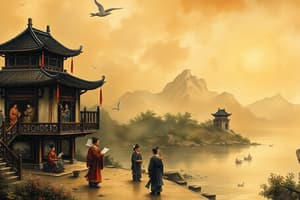Podcast
Questions and Answers
What is the Han Dynasty referred to as in Chinese history?
What is the Han Dynasty referred to as in Chinese history?
- A period of instability
- A time of war
- An era of decline
- A golden age (correct)
Who founded the Han Dynasty in 206 BCE?
Who founded the Han Dynasty in 206 BCE?
- Qin Shi Huang
- Emperor Wu
- Liu Bang, also known as Emperor Gaozu (correct)
- Emperor Guangwu
What was the outcome of Emperor Wu's reign?
What was the outcome of Emperor Wu's reign?
- A period of instability followed
- The empire's territory was reduced
- Cultural and economic growth was fostered (correct)
- The dynasty was overthrown
What happened to the Han Dynasty after Emperor Wu's reign?
What happened to the Han Dynasty after Emperor Wu's reign?
What was the duration of the Han Dynasty?
What was the duration of the Han Dynasty?
What was the impact of the Han Dynasty on Chinese culture?
What was the impact of the Han Dynasty on Chinese culture?
What was the role of Emperor Guangwu in the Han Dynasty?
What was the role of Emperor Guangwu in the Han Dynasty?
Who is credited with inventing paper around 105 CE during the Han Dynasty?
Who is credited with inventing paper around 105 CE during the Han Dynasty?
What was a significant outcome of the Han Dynasty's agricultural reforms?
What was a significant outcome of the Han Dynasty's agricultural reforms?
What was the main purpose of the Silk Road established during the Han Dynasty?
What was the main purpose of the Silk Road established during the Han Dynasty?
What was a major industry during the Han Dynasty that became a significant source of revenue?
What was a major industry during the Han Dynasty that became a significant source of revenue?
What was the outcome of the Han Dynasty's adoption of Confucianism as the state philosophy?
What was the outcome of the Han Dynasty's adoption of Confucianism as the state philosophy?
What was the significance of the civil service examinations established during the Han Dynasty?
What was the significance of the civil service examinations established during the Han Dynasty?
What was a characteristic of the Han Dynasty's art, literature, and architectural styles?
What was a characteristic of the Han Dynasty's art, literature, and architectural styles?
What was the overall impact of the Han Dynasty's economic policies and agricultural reforms?
What was the overall impact of the Han Dynasty's economic policies and agricultural reforms?
Flashcards are hidden until you start studying
Study Notes
Introduction to the Han Dynasty
- The Han Dynasty was a pivotal era in Chinese history, lasting over 400 years and known for its cultural and innovation achievements.
- The dynasty was established in 206 BCE, following the collapse of the Qin Dynasty, and brought a new era of stability and prosperity to China.
Han Dynasty Emperors
- Emperor Gaozu, Liu Bang, founded the Han Dynasty in 206 BCE after the collapse of the Qin Dynasty.
- Emperor Wu expanded the empire's territory and fostered cultural and economic growth during his reign.
- Emperor Guangwu restored the Han Dynasty after the brief interruption of the Xin Dynasty, reuniting China and revitalizing governance and culture.
Achievements and Innovations of the Han Dynasty
- Cai Lun, a government official, invented paper around 105 CE, revolutionizing communication and record-keeping in ancient China.
- The Han Dynasty made significant advancements in metallurgy, particularly in iron and steel production.
- The dynasty saw cultural flourishing, with advancements in music, dance, literature, and art, including the establishment of Confucianism as the state philosophy.
Economy and Trade of the Han Dynasty
- The Han Dynasty implemented economic policies and agricultural reforms that transformed China's economy, contributing to its prosperity and growth.
- The dynasty introduced land reforms, irrigation systems, and incentives for farmers to increase agricultural productivity.
- The establishment of the Silk Road facilitated trade and cultural exchange between China, Central Asia, and the Mediterranean region, leading to economic prosperity and the spread of ideas and technologies.
- Silk production was a major industry during the Han Dynasty, with the silk trade becoming a significant source of revenue and cultural exchange between East and West.
Legacy of the Han Dynasty
- The Han Dynasty's adoption of Confucianism as the state philosophy cemented its influence on Chinese culture and governance, shaping moral values and societal ethics.
- The establishment of civil service examinations during the Han Dynasty led to a merit-based system of selecting officials, ensuring competence and efficiency in governance.
- The art, literature, and architectural styles of the Han Dynasty influenced subsequent Chinese artistic traditions, reflecting elegance, refinement, and cultural sophistication.
Studying That Suits You
Use AI to generate personalized quizzes and flashcards to suit your learning preferences.




